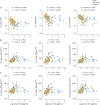Neurofilament light as a biomarker in traumatic brain injury
- PMID: 32641538
- PMCID: PMC7455357
- DOI: 10.1212/WNL.0000000000009983
Neurofilament light as a biomarker in traumatic brain injury
Erratum in
-
Neurofilament Light as a Biomarker in Traumatic Brain Injury.Neurology. 2021 Mar 23;96(12):593. doi: 10.1212/WNL.0000000000011716. Neurology. 2021. PMID: 33753531 Free PMC article. No abstract available.
Abstract
Objective: To determine whether serum neurofilament light (NfL) correlates with CSF NfL, traumatic brain injury (TBI) diagnosis, injury severity, brain volume, and diffusion tensor imaging (DTI) estimates of traumatic axonal injury (TAI).
Methods: Participants were prospectively enrolled in Sweden and the United States between 2011 and 2019. The Swedish cohort included 45 hockey players with acute concussion sampled at 6 days, 31 with repetitive concussion with persistent postconcussive symptoms (PCS) assessed with paired CSF and serum (median 1.3 years after concussion), 28 preseason controls, and 14 nonathletic controls. Our second cohort included 230 clinic-based participants (162 with TBI and 68 controls). Patients with TBI also underwent serum, functional outcome, and imaging assessments at 30 (n = 30), 90 (n = 48), and 180 (n = 59) days and 1 (n = 84), 2 (n = 57), 3 (n = 46), 4 (n = 38), and 5 (n = 29) years after injury.
Results: In athletes with paired specimens, CSF NfL and serum NfL were correlated (r = 0.71, p < 0.0001). CSF and serum NfL distinguished players with PCS >1 year from PCS ≤1 year (area under the receiver operating characteristic curve [AUROC] 0.81 and 0.80). The AUROC for PCS >1 year vs preseason controls was 0.97. In the clinic-based cohort, NfL at enrollment distinguished patients with mild from those with moderate and severe TBI (p < 0.001 and p = 0.048). Serum NfL decreased over the course of 5 years (ß = -0.09 log pg/mL, p < 0.0001) but remained significantly elevated compared to controls. Serum NfL correlated with measures of functional outcome, MRI brain atrophy, and DTI estimates of TAI.
Conclusions: Serum NfL shows promise as a biomarker for acute and repetitive sports-related concussion and patients with subacute and chronic TBI.
Classification of evidence: This study provides Class III evidence that increased concentrations of NfL distinguish patients with TBI from controls.
© 2020 American Academy of Neurology.
Figures





Comment in
-
Progress in the diagnosis of traumatic brain injury.Neurology. 2020 Aug 11;95(6):235-236. doi: 10.1212/WNL.0000000000009992. Epub 2020 Jul 8. Neurology. 2020. PMID: 32641522 No abstract available.
References
-
- Maas AIR, Menon DK, Adelson PD, et al. . Traumatic brain injury: integrated approaches to improve prevention, clinical care, and research. Lancet Neurol 2017;16:987–1048. - PubMed
Publication types
MeSH terms
Substances
LinkOut - more resources
Full Text Sources
Other Literature Sources
Medical
Research Materials
